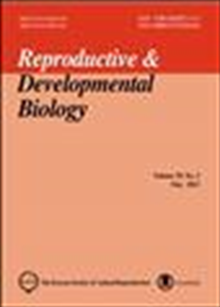간행물
Reproductive & developmental biology

- 발행기관 한국동물번식학회
- 자료유형 학술지
- 간기 계간
- ISSN 1738-2432 (Print)2288-0151 (Online)
- 수록기간 1977 ~ 2018
- 주제분류 농수해양 > 축산학 농수해양 분류의 다른 간행물
- 십진분류KDC 527DDC 636
권호리스트/논문검색
Volume 38 No 2 (2014년 6월) 4건
1.
2014.06
구독 인증기관 무료, 개인회원 유료
Plasminogen activators (PAs) are serine proteases that convert plasminogen to plasmin. Two type of PAs are urokinase-type PA (uPA) and tissue-type PA (tPA). Plasminogen is present in most extracellular fluids. PAs play in various reproductive processes including implantation, ovulation and fertilization. In the spermatozoa, PAs and PAIs play a role in sperm motility and fertilization. PAs in the sertoli cell are stimulated spermatozoa maturation and sperm activation through the phospholipase A2. The oocyte maturation is the process for fertilization and implantation. PAs in cumulus-oocyte complexes (COCs) are related to oocyte maturation by protein kinase A and C. In the ovulatory process, PAs activity are changed and it are related to reducing the tensile strength of ovarian follicle wall. The uterine environment is important for reproduction and the uterus undergo tissue remodeling. In the uterus and oviduct of mammals, expression and activity of PAs are changed during estrous cycle. Thus, expression and activity of PAs are concerned to many reproductive functions. Therefore, PAs seem to important factor of regulator in reproductive events.
4,000원
2.
2014.06
구독 인증기관 무료, 개인회원 유료
The specific genetic modification in porcine somatic cells by gene targeting has been very difficult because of low efficiency of homologous recombination. To improve gene targeting, we designed three kinds of knock-out vectors with α1,3-galactosyltransferase gene (α1,3-GT gene), DT-A/pGT5’/neo/pGT3’, DT-A/NLS/pGT5’/neo/pGT3’ and pGT5’/neo/ pGT3’/NLS. The knock-out vectors consisted of a 4.8-kb fragment as the 5’ recombination arm (pGT5’) and a 1.9-kb fragment as the 3’ recombination arm (pGT3’). We used the neomycin resistance gene (neo) as a positive selectable marker and the diphtheria toxin A (DT-A) gene as a negative selectable marker. These vectors have a neo gene insertion in exon 9 for inactivation of α1,3-GT locus. DT-A/pGT5’/neo/pGT3’ vector contain only positive-nega-tive selection marker with conventional targeting vector. DT-A/NLS/pGT5’/neo/pGT3’ vector contain positive-negative selection marker and NLS sequences in upstream of 5’ recombination arm which enhances nuclear transport of foreign DNA into bovine somatic cells. pGT5’/neo/pGT3’/NLS vector contain only positive selection marker and NLS sequence in downstream of 3’ recombination arm, not contain negative selectable marker. For transfection, linearzed vectors were introduced into porcine ear fibroblasts by electroporation. After 48 hours, the transfected cells were selected with 300 μg/ml G418 during 12 day. The G418-resistant colonies were picked, of which 5 colonies were positive for α1,3-GT gene disruption in 3´ PCR and southern blot screening. Three knock-out somatic cells were obtained from DT-A/NLS/ pGT5’/neo/pGT3’ knock-out vector. Thus, these data indicate that gene targeting vector using nuclear localization signal and negative selection marker improve targeting efficiency in porcine somatic cells.
4,000원
3.
2014.06
구독 인증기관 무료, 개인회원 유료
MicroRNAs (miRNAs) are approximately 22 nucleotides of small noncoding RNAs that control gene expression at the posttranscriptional level through translational inhibition and destabilization of their target mRNAs. The miRNAs are phylogenetically conserved and have been shown to be instrumental in a wide variety of key biological processes including cell cycle regulation, apoptosis, metabolism, imprinting, and differentiation. Recently, a paper has shown that expression of the miRNA-302/367 cluster expressed abundantly in mouse and human embryonic stem cells (ESCs) can directly reprogram mouse and human somatic cells to induced pluripotent stem cells (iPSCs) efficiently in the absence of any of the four factors, Oct4, Sox2, c-Myc, and Klf4. To apply this efficient method to porcine, we analyzed porcine genomic sequence containing predicted porcine miRNA-302/367 cluster through ENSEMBL database, generated a non-replicative episomal vector system including miRNA-302/367 cluster originated from porcine embryonic fibro-blasts (PEF), and tried to make porcine iPSCs by transfection of the miRNA-302/367 cluster. Colonies expressing EGFP and forming compact shape were found, but they were not established as iPSC lines. Our data in this study show that pig miRNA-302/367 cluster could not satisfy requirement of PEF reprogramming conditions for pluripotency. To make pig iPSC lines by miRNA, further studies on the role of miRNAs in pluripotency and new trials of transfection with conventional reprogramming factors are needed.
4,000원
4.
2014.06
구독 인증기관 무료, 개인회원 유료
Min Hee Park, Ji Eun Park, Min Seong Kim, Kwon Young Lee, Jung Im Yun, Jung Hoon Choi, Eunsong Lee, Seung Tae Lee
Despite many researches related with in-vitro culture of porcine spematogonial stem cells (SSCs), adherent culture system widely used has shown a limitation in the maintenance of porcine SSC self-renewal. Therefore, in order to overcome this obstacle, suspension culture, which is known to have numerous advantage over adherent culture, was applied to the culture of porcine SSCs. Porcine SSCs retrieved from neonatal testes were suspension-cultured for 5 days or 20 days, and characteristics of suspension-cultured porcine SSCs including proliferation, alkaline phosphatase (AP) activity, and self-renewal-specific gene expression were investigated and compared with those of adherent-cul-tured porcine SSCs. As the results, the suspension-cultured porcine SSCs showed entirely non-proliferative and significantly higher rate of AP-positive cells and expression of self-renewal-specific genes than the adherent-cultured porcine SSCs. In addition, long-term culture of porcine SSCs in suspension condition induced significant decrease in the yield of AP staining-positive cells on post-day 10 of culture. These results showed that suspension culture was inappropriate to culture porcine SSCs, because the culture of porcine SSCs in suspension condition didn’t stimulate proliferation and maintain AP activity of porcine SSCs, regardless of culture periods.
4,000원

